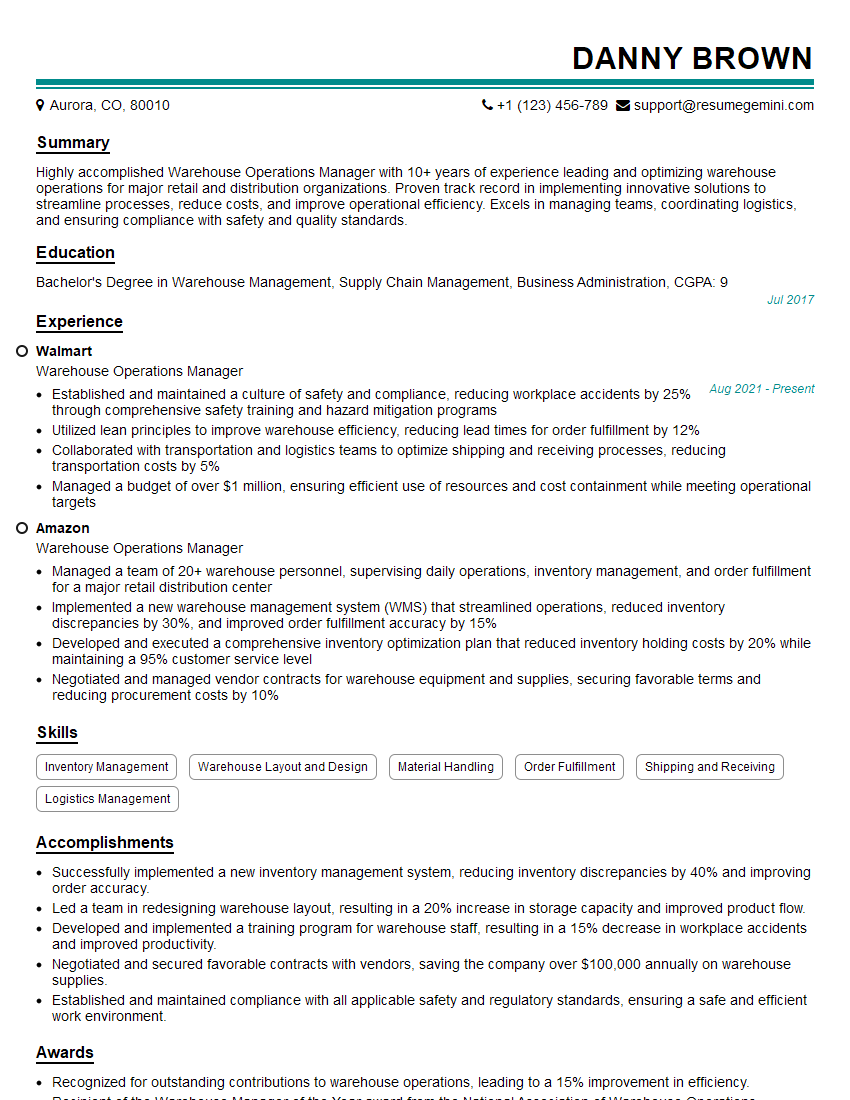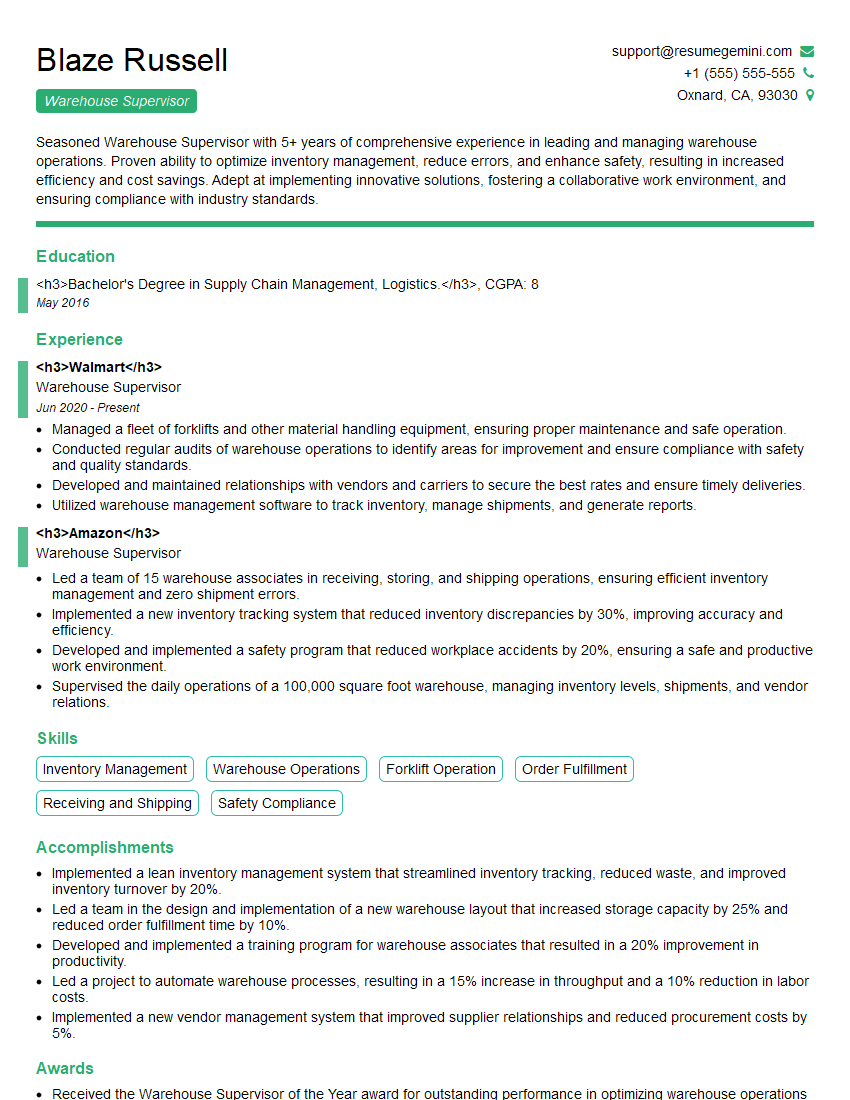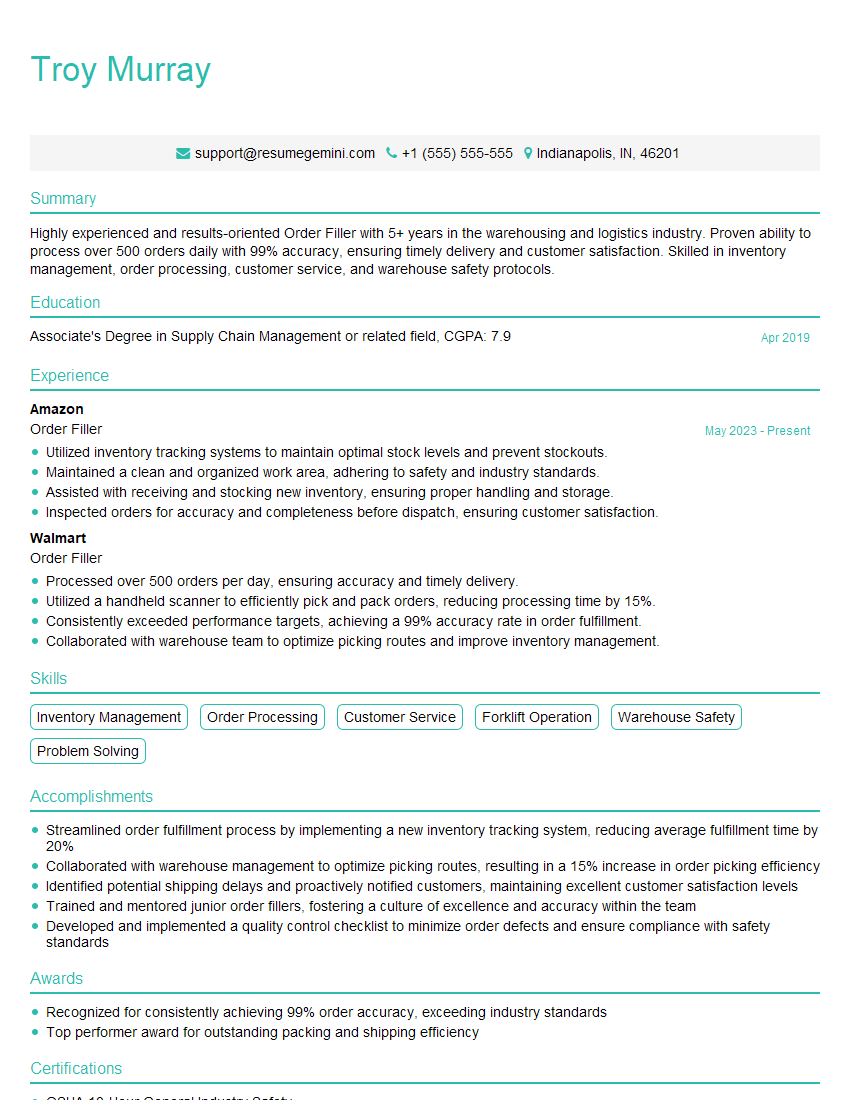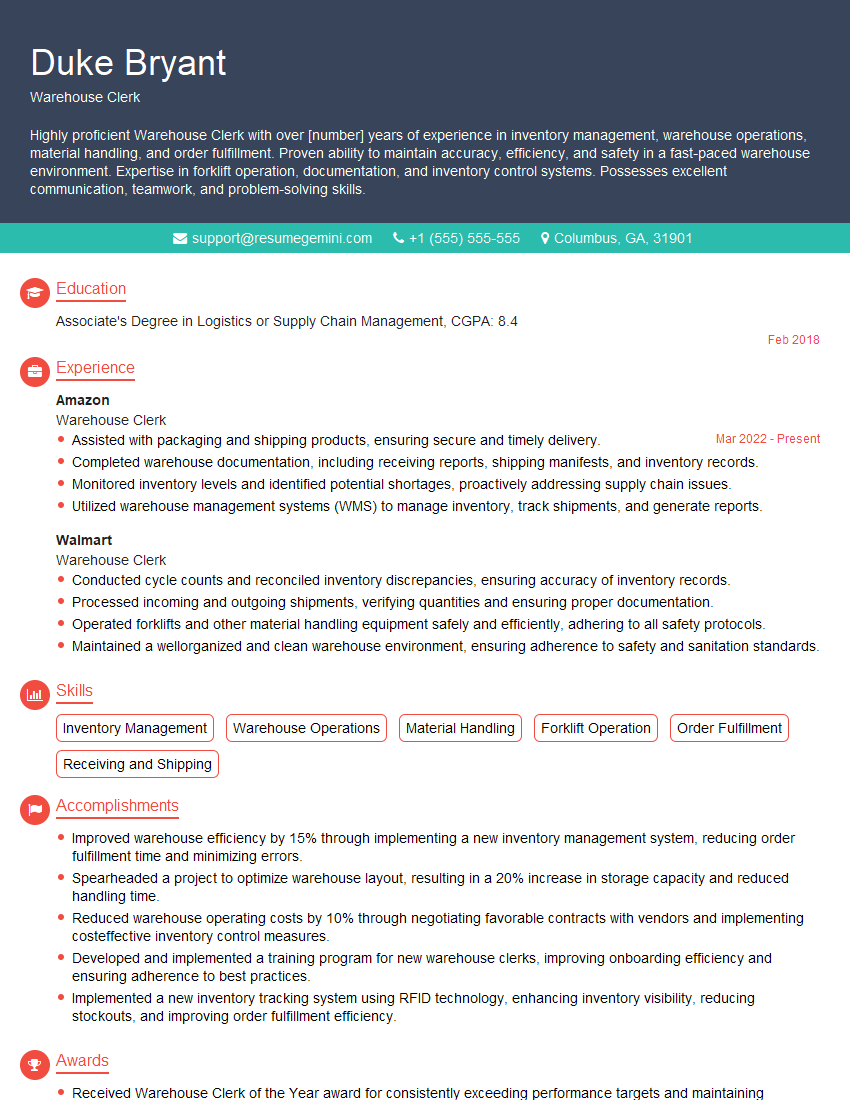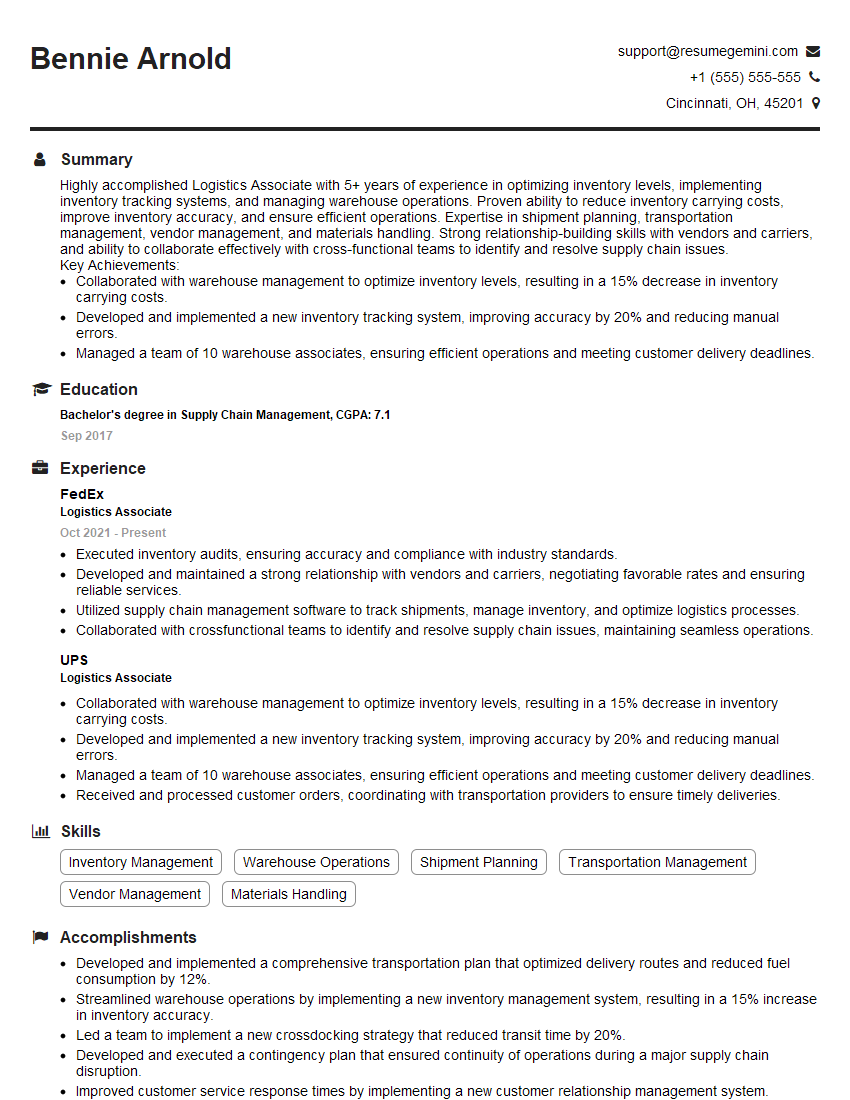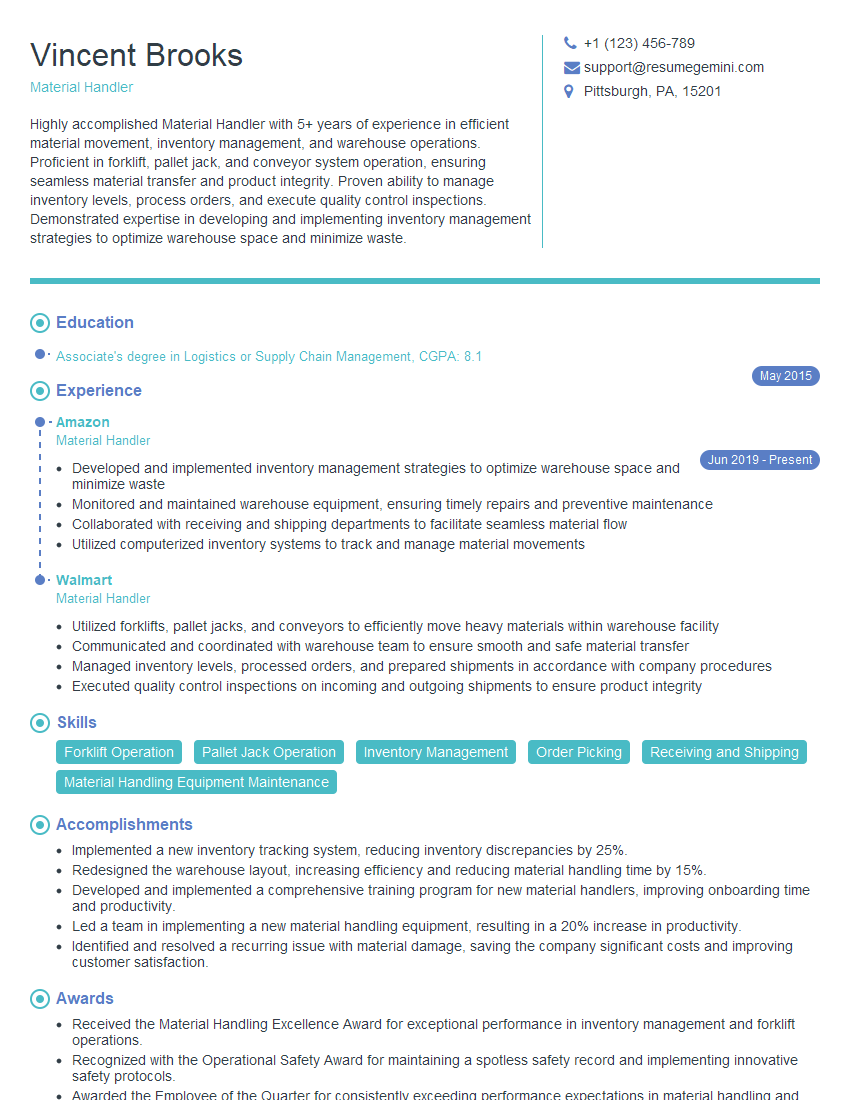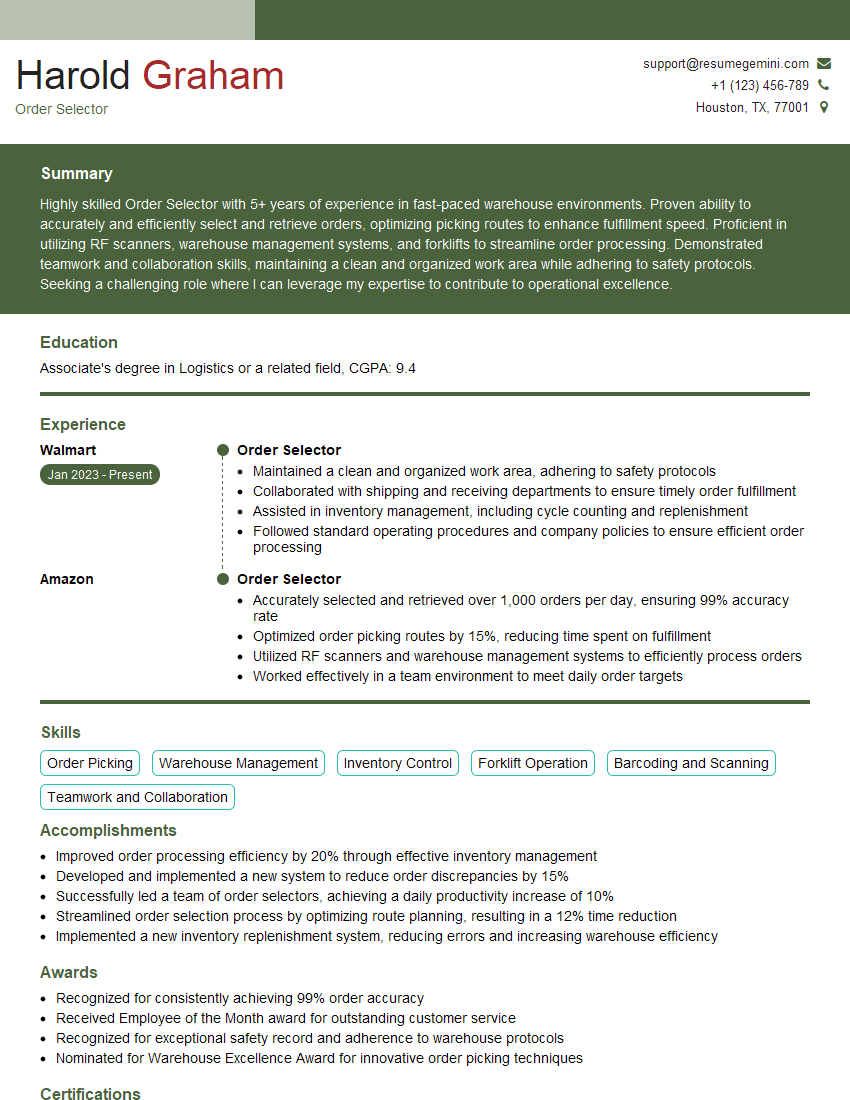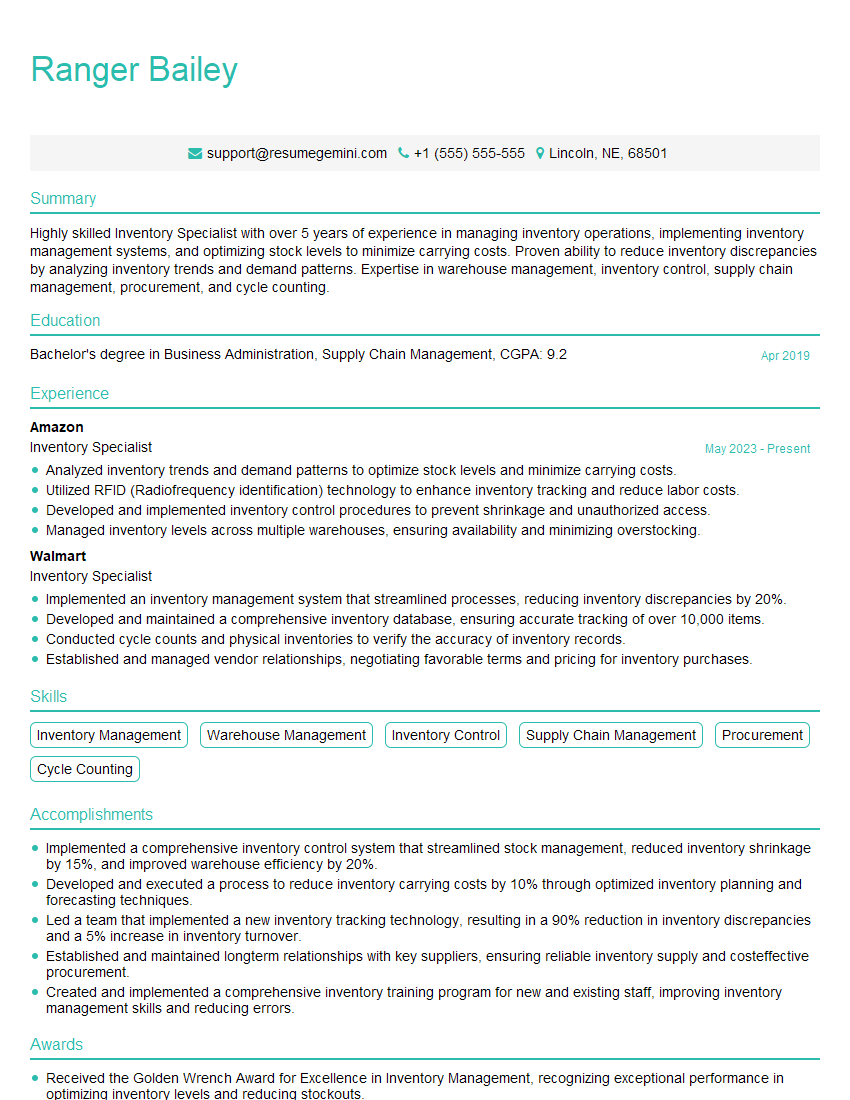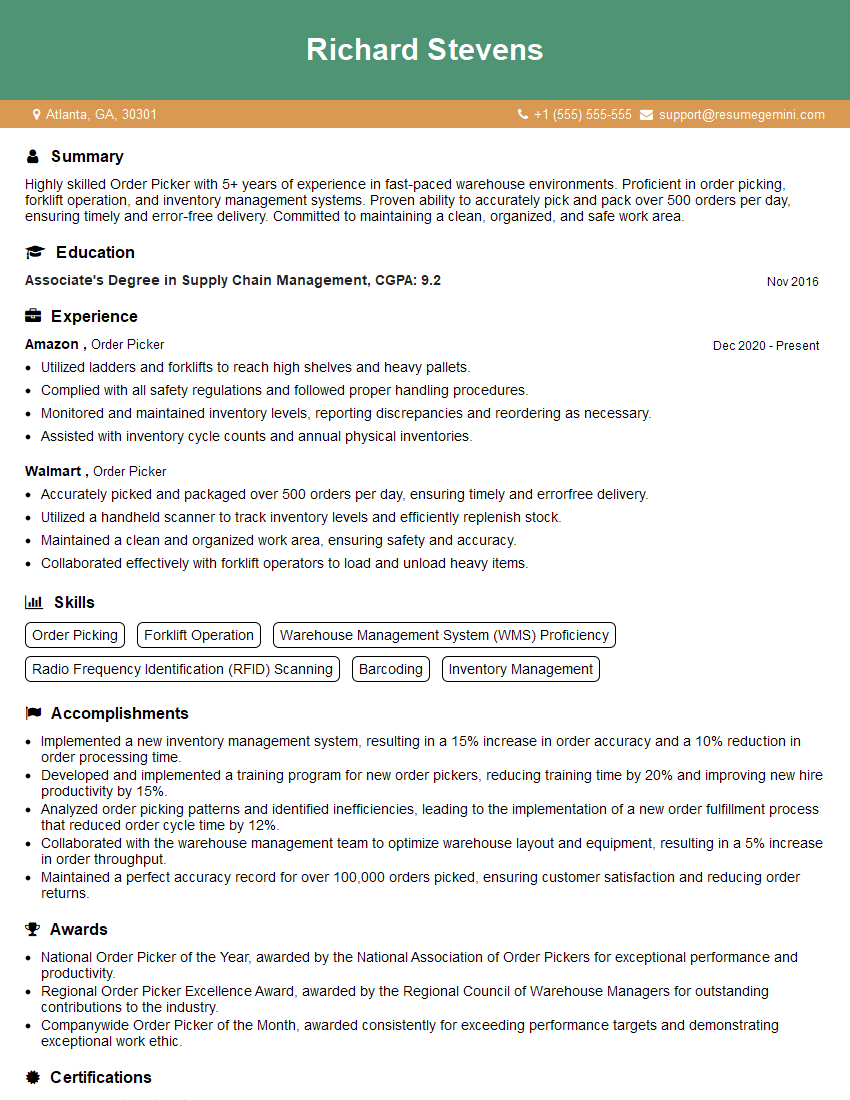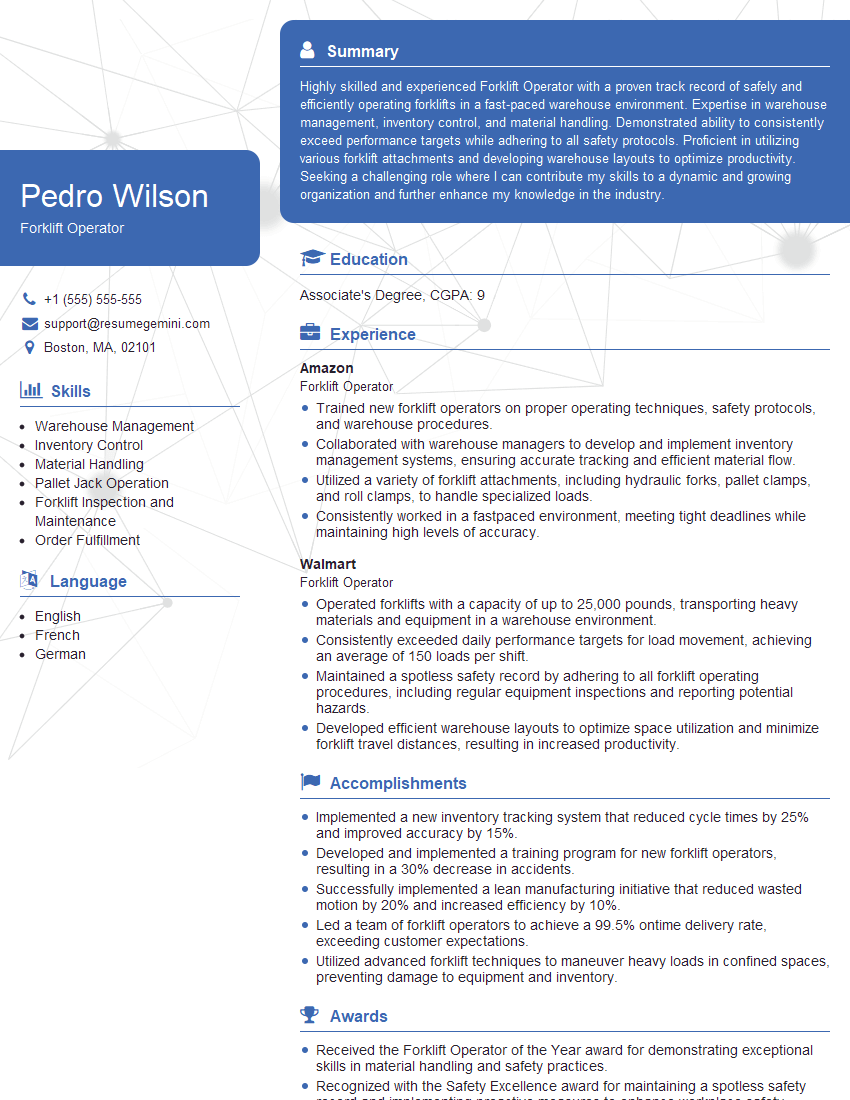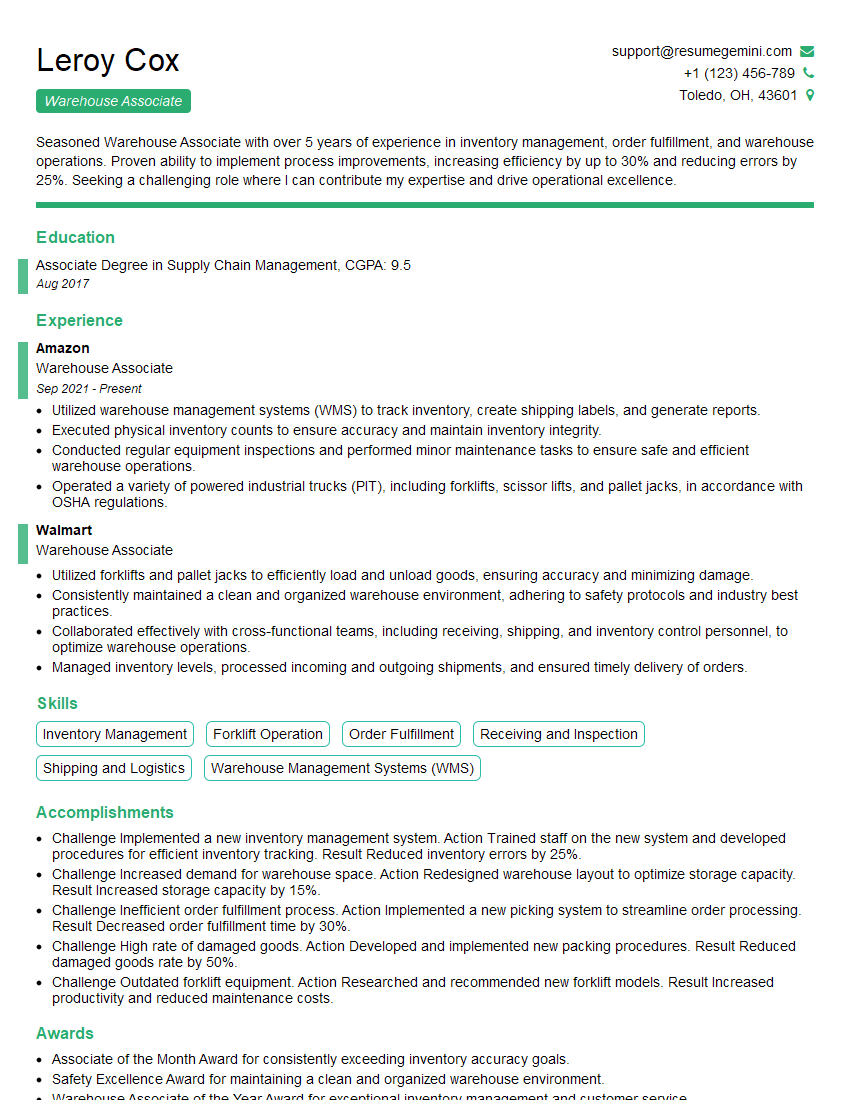Interviews are more than just a Q&A session—they’re a chance to prove your worth. This blog dives into essential Forklift Operation and Warehousing interview questions and expert tips to help you align your answers with what hiring managers are looking for. Start preparing to shine!
Questions Asked in Forklift Operation and Warehousing Interview
Q 1. What types of forklifts have you operated?
Throughout my career, I’ve operated a variety of forklifts, each suited to different tasks and warehouse layouts. This includes:
- Counterbalance forklifts: These are the most common type, ideal for general material handling in open spaces. I’m proficient in operating both gas-powered and electric models, understanding the nuances of each.
- Reach trucks: I have extensive experience with reach trucks, utilizing their ability to access high racking systems efficiently and safely. This requires precise control and understanding of load center.
- Order pickers: I’m skilled in using order pickers for picking and placing items in high-bay warehouses, prioritizing speed and accuracy. Safety protocols within narrow aisles are second nature to me.
- Sit-down forklifts: I’m comfortable with various models of sit-down forklifts, adapting my operation based on load weight, travel distance, and warehouse environment.
My experience extends to operating forklifts with various attachments, such as clamps, side-shifters, and rotating forks, further enhancing my versatility.
Q 2. Describe your experience with pre-operation forklift inspections.
Pre-operation inspections are non-negotiable for safe forklift operation. I follow a strict checklist, ensuring every aspect of the forklift is in optimal working condition. This includes:
- Visual Inspection: Checking for any damage to the forks, mast, tires, body, and safety features like lights, horn, and seatbelt.
- Fluid Levels: Verifying engine oil, hydraulic fluid, and coolant levels are within the acceptable range. Low levels can compromise performance and safety.
- Tire Condition: Inspecting tire pressure and tread depth to ensure stability and prevent punctures. Uneven tire wear is a sign of potential mechanical issues.
- Operational Checks: Testing the horn, lights, brakes, steering, and hydraulic functions to ensure everything is responding correctly. I’ll perform a test lift to check for smooth and stable operation.
- Safety Features: Confirming that all safety features such as seatbelts, backup alarms, and safety guards are functioning properly and securely attached.
I document any issues found during the inspection and report them to my supervisor immediately. Operating a forklift with even minor defects is unacceptable.
Q 3. Explain the proper procedures for loading and unloading goods.
Loading and unloading goods requires meticulous attention to detail and safety. My procedure involves:
- Assessment: Evaluating the weight and size of the load, the stability of the stacking, and the condition of the pallet to ensure safe handling.
- Positioning: Positioning the forklift strategically to minimize maneuvering and avoid collisions with other equipment or personnel. Clear communication with other warehouse staff is vital.
- Lifting: Carefully lifting the load, ensuring it’s evenly distributed and securely placed on the forks. Avoid sudden jerky movements.
- Transportation: Navigating the warehouse safely, maintaining a slow and controlled speed, especially in congested areas. Maintaining a safe distance from pedestrians and other equipment is crucial.
- Placement: Accurately and securely placing the load at its designated location, ensuring it’s stable and won’t topple. This involves using appropriate racking systems and following proper stacking techniques.
- Lowering: Slowly and gently lowering the load to the ground to avoid damage or injury.
I always prioritize safety and efficiency, ensuring the entire process is smooth and doesn’t compromise the integrity of the goods or the safety of those around me.
Q 4. How do you ensure safe operation of a forklift in a busy warehouse environment?
Safe forklift operation in a busy warehouse environment requires a multi-faceted approach:
- Awareness: Maintaining constant awareness of surroundings, including pedestrians, other equipment, and potential obstacles. This requires anticipating movements and adjusting my driving accordingly.
- Speed Control: Operating at a safe speed appropriate for the conditions and load. Reducing speed in congested areas and around corners is essential.
- Horn Usage: Using the horn effectively to warn pedestrians and other operators of my presence and intended maneuvers.
- Communication: Maintaining clear communication with other warehouse staff using hand signals, verbal communication, or designated communication systems.
- Designated Paths: Following designated traffic routes and avoiding unnecessary maneuvers. Knowing the warehouse layout and potential blind spots is crucial.
- Load Security: Ensuring loads are secured and stable, preventing them from shifting or falling during transit.
Following these principles helps prevent accidents and maintains a safe working environment for everyone.
Q 5. What are the common causes of forklift accidents and how can they be prevented?
Forklift accidents often stem from preventable causes:
- Unsafe Operating Practices: Speeding, reckless driving, improper load handling, and ignoring safety procedures are common culprits.
- Poor Maintenance: Malfunctioning equipment, inadequate inspections, and delayed repairs contribute significantly to accidents.
- Inadequate Training: Operators lacking proper training on safe operating procedures and emergency response are at increased risk.
- Poor Communication: Lack of communication between operators and pedestrians can lead to collisions.
- Environmental Hazards: Poor lighting, congested aisles, and uneven floors can create unsafe conditions.
Prevention involves comprehensive training programs, regular equipment maintenance, adherence to safety protocols, and a strong emphasis on communication and awareness within the warehouse.
Q 6. What is your experience with different types of warehouse racking systems?
I have experience working with various warehouse racking systems, including:
- Selective Pallet Racking: This is the most common type, offering easy access to individual pallets. I understand the importance of proper load placement and weight distribution to maintain stability.
- Drive-In/Drive-Through Racking: This system maximizes storage capacity but requires careful maneuvering and knowledge of load restrictions.
- Push-Back Racking: Similar to drive-in/drive-through, but with improved accessibility to individual pallets. Understanding the mechanics of this system is essential for efficient operation.
- Double-Deep Racking: This system provides higher storage density but demands precise forklift operation and awareness of load limitations.
- Cantilever Racking: Ideal for long or bulky items, I am proficient in safely handling such items and utilizing this racking system correctly.
Understanding the limitations and safe operating procedures for each racking system is crucial to prevent accidents and maintain efficiency.
Q 7. How do you handle damaged goods or incorrect orders?
Handling damaged goods or incorrect orders involves a structured approach:
- Identification: Carefully identifying the damaged goods or incorrect order, documenting the specifics, such as damage type, quantity, and order number.
- Segregation: Setting aside the affected goods to prevent them from being further damaged or mistakenly shipped.
- Reporting: Reporting the issue to the supervisor or designated personnel, providing detailed information about the situation.
- Documentation: Completing necessary paperwork, including damage reports and order discrepancies, providing clear and accurate details. Photos of the damage are frequently helpful.
- Follow-up: Following up on the issue to ensure that it’s resolved appropriately, whether that’s replacing damaged goods, rectifying the order, or initiating a return process.
My approach prioritizes accuracy and efficiency, ensuring that damaged or incorrect orders are handled promptly and professionally without impacting other warehouse operations.
Q 8. Describe your experience with inventory management systems.
My experience with inventory management systems spans several years and various platforms. I’m proficient in using both manual and automated systems, understanding their strengths and limitations. For example, I’ve extensively used systems like Fishbowl Inventory and NetSuite, managing everything from receiving and put-away to cycle counting and reporting. In smaller operations, I’ve successfully implemented and maintained spreadsheet-based inventory tracking systems, ensuring accuracy and efficiency even without dedicated software.
My expertise extends to understanding the importance of accurate data entry, regular stock audits, and integrating inventory management with order fulfillment processes. I understand the impact inaccurate inventory data can have on customer satisfaction, production scheduling, and overall profitability, so meticulous data management is paramount in my approach.
Q 9. How do you maintain accurate inventory records?
Maintaining accurate inventory records requires a multi-pronged approach combining technology and diligent practices. It starts with precise data entry at every stage – receiving, putaway, picking, and shipping. This involves double-checking quantities, verifying product codes, and promptly correcting any discrepancies. Regular cycle counting – a process of counting a subset of inventory regularly – is crucial. Instead of a complete annual inventory count, which disrupts operations, cycle counting allows for continuous monitoring and identification of discrepancies in a less disruptive manner.
I also leverage the power of technology. RF scanners allow for real-time updates to the system, eliminating manual data entry errors. WMS (Warehouse Management Systems) integrate all aspects of inventory tracking and provide valuable reports and analytics, facilitating proactive inventory management. Ultimately, accuracy is a product of attention to detail, consistent procedures, and leveraging technology appropriately.
Q 10. What is your experience with RF scanners and warehouse management systems (WMS)?
I have extensive experience using RF scanners and Warehouse Management Systems (WMS). RF scanners are an integral part of my daily routine, speeding up tasks like receiving, put-away, picking, and shipping. My proficiency extends to various scanner models and their integration with different WMS platforms. I’m comfortable troubleshooting scanner malfunctions and quickly adapting to new technologies. I can efficiently scan barcodes and utilize the scanners’ data-capture capabilities for accurate inventory tracking.
Regarding WMS, I have experience with several systems, allowing me to efficiently manage warehouse operations. I understand the importance of configuring and utilizing WMS features effectively, such as location management, task assignment, and reporting. I’m adept at using WMS data to analyze inventory levels, identify areas for improvement, and optimize warehouse workflows. For instance, I once identified a bottleneck in our picking process by analyzing WMS data, ultimately resulting in a 15% increase in picking efficiency.
Q 11. How do you prioritize tasks in a fast-paced warehouse setting?
Prioritizing tasks in a fast-paced warehouse environment requires a structured approach. I typically use a combination of urgency, importance, and dependencies to prioritize tasks. I start by identifying time-sensitive tasks, such as fulfilling urgent orders or addressing critical stock shortages. Next, I consider the importance of each task, focusing on those with the greatest impact on overall operations or customer satisfaction. Finally, I consider the dependencies between tasks, ensuring that prerequisite tasks are completed before proceeding to subsequent ones.
For example, if I have urgent orders to ship, receiving inbound shipments, and cycle counting scheduled, I’ll prioritize order fulfillment first due to its immediate impact on customer satisfaction. Then I might tackle inbound shipments to avoid storage bottlenecks, before finally allocating time for cycle counting.
Q 12. Describe your experience working with a team in a warehouse environment.
Teamwork is essential in a warehouse environment. I thrive in collaborative settings and actively contribute to a positive and efficient team dynamic. I’m comfortable communicating clearly and effectively with my colleagues, providing and receiving constructive feedback, and assisting others as needed. I believe in mutual respect and support; a strong team is built on trust and shared goals.
I’ve been part of teams that successfully navigated peak seasons, implemented new processes, and resolved operational challenges. One example is how we successfully implemented a new WMS, requiring extensive training and collaboration between the forklift operators, pickers, and management. My role in that process was ensuring other team members understood how to use the new system effectively and troubleshooting any issues that arose.
Q 13. How do you handle stressful situations in the warehouse?
Handling stressful situations in a warehouse requires a calm and methodical approach. My strategy focuses on maintaining composure, assessing the situation, and devising a solution. I start by identifying the root cause of the stress – is it a backlog of orders, equipment malfunction, or a personnel issue? Once identified, I develop a plan to address the problem. If needed, I will escalate the issue to my supervisor while maintaining a positive attitude and continuing to support my team.
For example, if there’s a sudden surge in orders during peak season, I’d calmly assess the situation, re-prioritize tasks with my team, and potentially request additional resources to ensure timely order fulfillment. It’s about problem-solving and adapting to unexpected challenges while maintaining productivity and a positive working environment.
Q 14. Explain your understanding of load capacity and weight distribution.
Understanding load capacity and weight distribution is crucial for safe and efficient forklift operation. Load capacity refers to the maximum weight a forklift can lift safely, while weight distribution refers to how that weight is balanced on the forks. Uneven weight distribution can lead to instability, potentially causing accidents. Forklifts have a data plate specifying their maximum load capacity, which must never be exceeded.
Proper weight distribution involves centering the load on the forks and ensuring the load is evenly distributed. Overloading or improper weight distribution can damage the forklift, injure the operator, or cause accidents. I always visually inspect the load to ensure it is secure and properly balanced before lifting. I’m familiar with different load types and use appropriate techniques for handling various materials, including palletized goods, loose items, and oversized loads. Safe operation always comes first.
Q 15. What safety measures do you follow when operating a forklift?
Forklift safety is paramount. My approach is multifaceted, starting with a pre-operation inspection of the forklift itself. I check tire pressure, fluid levels (hydraulic fluid, engine oil), lights, horn, and the overall structural integrity of the machine. Any issues are immediately reported to my supervisor. Then, I ensure I’m wearing appropriate Personal Protective Equipment (PPE), including a high-visibility vest, safety shoes, and a seatbelt (if the forklift is equipped with one). During operation, I maintain a safe speed, avoid jerky movements, and always sound the horn before making turns or approaching intersections. I never operate a forklift if I’m fatigued or under the influence of drugs or alcohol. Finally, I’m meticulous about properly securing loads to prevent tipping or shifting during transport. Imagine trying to balance a stack of books – securing the load is just as vital.
- Pre-shift Inspection: A thorough check of the forklift’s mechanical components before each use.
- PPE Usage: Consistently wearing safety gear.
- Safe Operation Practices: Maintaining slow speeds and using the horn appropriately.
- Load Securing: Proper use of straps, chains, or other load-securing devices to prevent accidents.
Career Expert Tips:
- Ace those interviews! Prepare effectively by reviewing the Top 50 Most Common Interview Questions on ResumeGemini.
- Navigate your job search with confidence! Explore a wide range of Career Tips on ResumeGemini. Learn about common challenges and recommendations to overcome them.
- Craft the perfect resume! Master the Art of Resume Writing with ResumeGemini’s guide. Showcase your unique qualifications and achievements effectively.
- Don’t miss out on holiday savings! Build your dream resume with ResumeGemini’s ATS optimized templates.
Q 16. How do you ensure the safety of pedestrians in the warehouse?
Pedestrian safety is my top priority. I always adhere to designated pedestrian walkways and clearly marked areas. I use caution lights and slow down significantly in high-traffic areas, ensuring I have a clear path. I make eye contact with pedestrians whenever possible and communicate my intentions (e.g., by gently sounding the horn to signal my approach). I also actively avoid blind spots by utilizing mirrors and turning slowly and carefully. Furthermore, I strictly enforce rules against unauthorized personnel in designated forklift operating areas. I’ve implemented a system where pedestrians always have the right-of-way, requiring them to acknowledge me before I start my operation to ensure they see me coming.
One time, a new employee almost walked into my path. I immediately stopped and politely addressed the situation, explaining the importance of following safety protocols. The incident emphasized the value of consistent communication and proactive pedestrian safety measures.
Q 17. What is your experience with different types of warehouse equipment (e.g., pallet jacks, conveyor belts)?
My experience extends beyond forklift operation to encompass a wide range of warehouse equipment. I’m proficient in using pallet jacks for manual material handling, understanding their limitations and safe operating procedures. I’m familiar with various conveyor belt systems, including their controls, safety mechanisms, and potential hazards, like pinch points and moving parts. I’ve also worked with order pickers, reach trucks, and stackers, each requiring specific safety training and operational knowledge. I understand the interplay between different equipment types in a warehouse setting. For instance, using pallet jacks to feed conveyors efficiently and avoid blockages. I always prioritize safety and efficiency in my equipment usage.
Q 18. How do you maintain a clean and organized workspace?
Maintaining a clean and organized workspace is crucial for safety and efficiency. My approach is systematic: I start with clearing any unnecessary debris or materials immediately after completing a task. I then organize pallets and materials according to established warehouse layout procedures. Regular sweeping or vacuuming is performed to eliminate trip hazards. Aisles are kept clear, and any spills are cleaned up immediately. This not only improves safety but also boosts operational efficiency as it reduces the time spent searching for items or navigating cluttered pathways. Think of it like organizing a desk – a clean space promotes better workflow and reduces the potential for mistakes or accidents.
Q 19. What is your experience with receiving and shipping procedures?
I have extensive experience in receiving and shipping procedures, from verifying incoming shipments against purchase orders to accurately preparing outgoing orders. This includes checking for damages, quantity discrepancies, and ensuring products are correctly labeled and packaged. I’m familiar with various shipping documents (e.g., Bills of Lading, packing slips), understanding the importance of accurate documentation and traceability. I’ve utilized Warehouse Management Systems (WMS) for inventory tracking and order processing, leading to more efficient and accurate operations. My experience includes managing inventory cycles, utilizing barcode scanners and other technologies to expedite workflows. A well-organized receiving and shipping process is the backbone of a successful warehouse.
Q 20. How familiar are you with OSHA regulations for forklift operation?
I am highly familiar with OSHA regulations for forklift operation. I understand the requirements for operator training, certification, and pre-operation inspections, and I always maintain my certification to reflect my adherence to these standards. I know the regulations regarding load capacity, speed limits, and safe operating procedures in various environments. My knowledge extends to the reporting of accidents and near misses, complying with all post-incident reporting procedures. I believe that continuous education and adherence to OSHA regulations are crucial for maintaining a safe work environment. It’s not just about following rules; it’s about safeguarding myself and my colleagues.
Q 21. Describe your experience with using a forklift in a narrow aisle environment.
Operating a forklift in narrow aisle environments requires specialized skills and a high degree of precision. I have significant experience operating narrow aisle forklifts, including reach trucks and very narrow aisle (VNA) trucks. This experience includes understanding the limitations of these machines in confined spaces. I understand the importance of careful maneuvering, precise steering, and slow, deliberate movements. I always assess the aisle width before entering and ensure that the load is appropriately sized and stable to prevent collisions with racks or walls. My experience has honed my ability to efficiently and safely navigate these spaces with minimal risk. In essence, the key to successful operation in these environments is caution and patience. A rushed approach can be disastrous.
Q 22. How do you troubleshoot minor forklift malfunctions?
Troubleshooting minor forklift malfunctions starts with safety. Always ensure the forklift is turned off and the area is secure before attempting any repairs. My approach involves a systematic check, starting with the most obvious issues.
Check the Battery: Low battery power is a frequent culprit for reduced performance. I’d check the battery indicator and, if necessary, connect a charger.
Hydraulic System: Leaks in the hydraulic lines can cause loss of lift capacity or steering problems. I’d carefully inspect all hoses and connections for any signs of leakage. A slight drip might be manageable, but significant leakage requires immediate attention and reporting to my supervisor.
Tires: Flat or damaged tires can affect maneuverability and stability. I’d visually inspect the tires for punctures, excessive wear, or other damage. A flat tire requires professional attention.
Controls: If the controls feel sluggish or unresponsive, the issue might lie within the control system itself. This necessitates a more thorough inspection, likely requiring the expertise of a mechanic. I wouldn’t attempt to fix this independently.
Warning Lights and Indicators: Pay close attention to any warning lights on the dashboard. They usually provide clues about the problem. For example, a flashing hydraulic warning light suggests a critical issue that needs immediate attention and should be reported immediately.
If the problem persists after these checks, I’d report it to my supervisor immediately and follow company protocol for reporting forklift malfunctions. Safety is always the top priority.
Q 23. What is your experience with using different types of attachments for forklifts?
I have extensive experience using various forklift attachments, adapting my approach to the specific task and load. This includes:
Standard Forks: My most common experience. I’m proficient in handling various pallet sizes and weights, ensuring secure placement and load stability.
Clamp Attachments: I’ve used these extensively for handling materials like lumber, sheet metal, or large blocks, understanding the importance of proper clamping force and securing the load to prevent shifting or damage.
Side Shifters: I’m skilled in operating side shifters to precisely position loads on pallets, maximizing space efficiency and minimizing the need for repositioning. It’s vital to maintain a safe operating distance to prevent accidents.
Rotators: Experience with rotator attachments has allowed me to efficiently handle long materials, like pipes or beams, by rotating them for optimal placement.
Paper Roll Clamps: Handling paper rolls safely and efficiently requires familiarity with the specific clamping mechanisms to prevent damage to the rolls or the forklift.
Before using any attachment, I meticulously inspect it for damage, ensuring secure attachment to the forklift and confirming its suitability for the load. Safety training and practical experience are key to proficient use of these attachments.
Q 24. How do you communicate effectively with your supervisor and coworkers?
Effective communication is critical in a warehouse environment. I prioritize clear, concise, and respectful communication with both my supervisor and coworkers. My approach involves:
Clear and Concise Reporting: I promptly report any issues, including forklift malfunctions, safety concerns, or unusual circumstances to my supervisor using established channels, typically verbal communication followed by a written report for any significant incidents.
Active Listening: I actively listen to instructions and feedback, asking clarifying questions if needed to ensure a complete understanding before proceeding. This is especially crucial in safety-critical tasks.
Teamwork and Collaboration: I collaborate effectively with coworkers, communicating potential obstacles or delays to avoid conflicts and maintain efficient workflow. For example, I’ll communicate my movement within the warehouse to co-workers operating other machinery.
Respectful and Professional Demeanor: I maintain a professional attitude and respect diverse communication styles, ensuring a positive and productive work environment.
Regular communication with my supervisor also helps me stay updated on changes in procedures, safety regulations, and warehouse layout.
Q 25. Describe a time you had to solve a problem related to forklift operation.
During a particularly busy shipment, a pallet unexpectedly shifted on my forks, causing it to become unstable. This threatened to damage nearby goods and potentially cause an accident. Instead of panicking, I immediately:
Stopped the Forklift: My first priority was safety. I brought the forklift to a complete stop in a safe location, away from other workers and equipment.
Assessed the Situation: I carefully evaluated the situation, noting the extent of the pallet’s instability and the potential hazards.
Developed a Solution: Instead of trying to lift it further, which could have worsened the situation, I carefully lowered the load. I then used additional straps to secure the pallet before carefully repositioning it.
Reported the Incident: I documented the incident and reported it to my supervisor, detailing the circumstances and the measures taken to address the problem. This allowed the team to review procedures and implement any necessary changes to prevent similar situations in the future.
This experience reinforced the importance of careful load assessment, secure handling techniques, and immediate problem solving in a fast-paced warehouse environment. The solution prioritized safety, efficiency and compliance.
Q 26. What are your strengths and weaknesses as a forklift operator?
My strengths as a forklift operator include:
Safety-Consciousness: I prioritize safety above all else, adhering to all safety regulations and procedures.
Efficiency: I am highly efficient in moving materials and optimizing warehouse space, and maintain a high level of productivity while maintaining the safety standards.
Problem-Solving Skills: I am adept at quickly identifying and resolving minor forklift issues, reducing downtime.
Attention to Detail: I pay close attention to details, ensuring that loads are secure and that work areas are clear of obstacles.
My main area for improvement is multitasking in high-pressure situations; While I manage it effectively, there’s always room for refinement. To address this, I regularly practice time-management techniques and prioritize tasks to maintain a steady workflow.
Q 27. Where do you see yourself in five years?
In five years, I see myself as a highly skilled and experienced forklift operator, possibly in a supervisory role. I aim to continue improving my skills, potentially obtaining advanced certifications and broadening my knowledge of warehouse management systems. My goal is to contribute significantly to the efficient and safe operation of a warehouse environment. I am particularly interested in utilizing new technologies improving warehouse efficiency and safety, such as automated guided vehicles (AGVs) and warehouse management systems (WMS).
Q 28. Do you have any questions for me?
Yes, I do. I’d like to know more about the company’s safety training programs and opportunities for professional development within the forklift operator role, including any chances to advance my career within the company.
Key Topics to Learn for Forklift Operation and Warehousing Interview
- Forklift Safety Procedures: Understanding and applying OSHA regulations, pre-operational checks, safe operating practices, and emergency procedures. Practical application includes describing your experience with safety protocols and incident reporting.
- Forklift Operation Techniques: Mastering various forklift types (e.g., sit-down, stand-up, reach truck), load handling techniques, maneuvering in tight spaces, and efficient load placement. Consider practical examples of challenging situations you’ve navigated.
- Warehouse Management Systems (WMS): Familiarity with common WMS software and their role in inventory management, order fulfillment, and tracking. This includes understanding how to use a scanner, pick tickets, and follow established warehouse procedures.
- Inventory Control and Management: Understanding inventory processes, cycle counting, stock rotation (FIFO/LIFO), and the impact of accurate inventory on warehouse efficiency. Highlight your experience with maintaining accurate inventory records.
- Warehouse Layout and Organization: Knowledge of efficient warehouse layouts, zoning, and best practices for optimizing workflow and minimizing travel time. Discuss your understanding of efficient storage and retrieval methods.
- Problem-Solving and Troubleshooting: Demonstrate your ability to identify and resolve common forklift issues, address loading/unloading challenges, and contribute to efficient warehouse operations. Prepare examples of problems you’ve solved in a warehouse setting.
- Teamwork and Communication: Highlight your ability to collaborate effectively with warehouse colleagues, supervisors, and other departments. This includes following instructions, communicating effectively, and contributing positively to a team environment.
Next Steps
Mastering Forklift Operation and Warehousing opens doors to rewarding careers with excellent growth potential. Companies highly value skilled and safety-conscious operators, offering opportunities for advancement into supervisory roles, specialized training, and increased earning potential. To maximize your job prospects, create a strong, ATS-friendly resume that highlights your skills and experience. ResumeGemini is a trusted resource that can help you build a professional resume that stands out to recruiters. Examples of resumes tailored to Forklift Operation and Warehousing are available to guide you.
Explore more articles
Users Rating of Our Blogs
Share Your Experience
We value your feedback! Please rate our content and share your thoughts (optional).
What Readers Say About Our Blog
Hi, I’m Jay, we have a few potential clients that are interested in your services, thought you might be a good fit. I’d love to talk about the details, when do you have time to talk?
Best,
Jay
Founder | CEO


